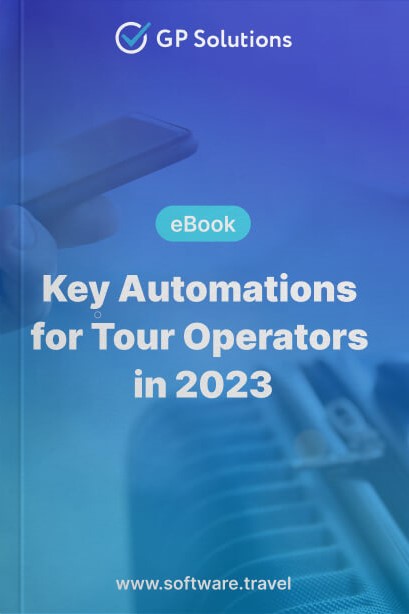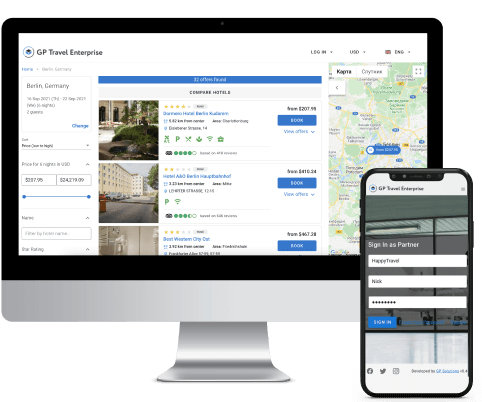- en
- de
Meet Us at Connect Spring Marketplace!
Meet Us at Connect Spring Marketplace!

In the current travel industry there is an abundance of tour operators – travel companies specialising in creation of tours by planning their structure, booking essential components and arranging distribution to either individual travellers or travel agents for reselling.
Depending on the type of activity, there can be:
There can also be more subdivisions depending on what criteria are used.
Overall, there are over 130,000 tour operator businesses handling tourism activities worldwide, with the total increase of the tour operator / travel agency market size to 474.4 Billion USD in 2023. The range of service offering is extremely diverse – ranging from standard events like guided tours in large cities to feeding rare animals in the most exotic parts of the globe. The interest for their services is abundant, versatile and is currently on the rise with the immense delayed demand kicking in after COVID-19.
Nevertheless, despite all the interest and stable market growth, tour operator businesses can hardly become successful without high-performing software infrastructure – the key component of today’s digitised commerce. This makes it extremely important to know how to navigate the technology landscape properly and make informed software choices. There always needs to be a pattern to follow that can help ‘connect the dots’ the right way in choosing technology for your business.
Here is our vision of the key milestones to work through en route to obtaining a high-performing tour operator software solution.

“Need help implementing tour operator software for your business? Let’s talk.”
Back-office is the cornerstone that binds tour operator software infrastructure together. It controls your entire business process automation. A modern tour operator back-office is a complex solution incorporating a wide range of apps and options responsible for:

The back-office element worthy of special attention is inventory. It serves as the central storage of travel products provided by tour operators to their tourists. One of its valuable functions is managing availability, meaning how many rooms, seats or tickets are available for the given product within the defined period of time.
Just as an illustration, here’s an example from our GP Travel Enterprise platform.

To implement a back-office that is capable of supporting your tour operator business growth for a long time, it is important to make sure that it is:
It makes sense to prioritize applications built using technologies that are both time-tested and widely-spread in implementing high-capacity back-end applications. Some examples are Java / Kotlin, Python or C#. But this is not the full list of options that can do the job.
Besides the programming languages, one must pay attention to:
Your software infrastructure should be able to extend and improve functionality quickly to adapt to changing market conditions. A rational way could be to opt for a well-developed solution containing multiple ready-made modules that can be plugged in or disconnected, if necessary.
Modern tour operator back-office must be open for all kinds of additional developments. These may include either customization of the system itself or connecting additional external applications via APIs (for ex., supplier inventories, payment systems, additional data feeds, etc.).
Check this article for a more in-depth study of contemporary tour operator back-office.
FREE EBOOK! Key Automations for Tour Operators in 2023
Get valuable insights and best practices from our team on the most important areas to focus on in modern tour operator business automation.
Get your copy today!

Another fundamental component of tour operator software solution is the booking engine, which is responsible for receiving and processing online booking requests from both individual travellers and agents. Such an engine must be linked to your inventory database or your suppliers’ travel products. Besides, it must connect to B2B and / or B2C interfaces to allow making reservations by system users. To additionally assist users in locating what they require, a booking engine should be equipped with well-developed search forms and workflows.
When selecting a booking engine, there are several noteworthy items to consider. Firstly, you need to make choices that fit your business format – B2B, B2C, or a combination of both.

Dynamic packaging functionality is also crucial if you want to let your clients adjust tour components instead of purchasing predefined tours. Your booking engine also needs to handle customizations and flexible dates for booked trips.
Another important aspect to work on is payments processing. It is a must for your booking engine to incorporate built-in payment gateways – the likes of Stripe, PayPal; there can also be multiple preferable options depending on the regions you operate in. Your software should also support diverse payment options: bank debit, mobile payments, credit cards, digital wallets, cryptocurrencies, etc. Other options like vouchers, gift certificates, payment instalments or deposits are also good to have.
Streamlined management of travel product suppliers is a highly important aspect to pay attention to as well. Unless you have your own fleet of aircrafts or a set of accommodations to provide to travellers, you are most likely purchasing inventory from external vendors. These are usually some or all of the following:
To automate reservation processes the most usual practice is to have your solution connected to various travel provider APIs. This way tour operators can send booking requests and get confirmation sent back to them along with other important status updates received within their own back-office. An important point to remember here is that the integration process can be quite time-consuming and requires qualified engineers to do the job. A rational way out here could be to look for a travel supplier aggregation solution that has numerous integrations available off-the-shelf. This way you can make just a single integration and gain access to multiple suppliers through it.

Another way to go is to establish an extranet and give direct access to your system and let suppliers manage their allotted inventories on their own. This scenario is more and more rare nowadays. Nevertheless it can work quite well, especially in case it is necessary to work with smaller local or niche vendors.
In contrast to companies from spheres like retail sales or manufacturing, the inventory of a travel business consists of individual travel services (hotels, flights, transfers, car rentals, etc.), tours and travel packages. The key objective of tour operators is to arrange these separate services into a marketable bundle, which is the complete tour distributed to clients and partners. This is their key difference compared to other market players. For this reason every tour operator must have the right software in its arsenal that can help perform this task according to the business model.

There are many specialised solutions on the market that serve the purpose of developing, scheduling and customising tour plans, or ‘itineraries’. Some of them are standalone, the others are built as a part of a larger ERP-level travel system. These solutions provide real-time availability of individual elements such as hotel beds and transportation seats. Intuitive user-friendly interfaces enable operators to arrange tour components and link them to a tour calendar. These solutions may also include destination content such as city guides and optional activities. For lengthy tours with multiple stops, automatic map-routing generation would be nice to have.
The final choice of the solution depends on what kind of tour operator you are and what kind of tour you sell – more standardised or tailor-made. In any way, there are systems available for all needs and budgets.
In order to optimise customer relationships, a strong CRM solution is practically a must nowadays. The ideal solution should automatically create profiles and store customer information and interaction history, while also offering additional features to facilitate communication and personalization. This may include the ability to easily create custom commercial documents – proposals, quotes, properly formatted invoices and more.

Many tour operator platforms incorporate a CRM module. Nevertheless, a standalone CRM platform could be required to provide more advanced functionality. If you already have a CRM, integration with your booking software is necessary to establish a seamless information flow. Luckily, many of the modern tour operator platforms have well-structured and documented APIs allowing to perform integrations productively and in various formats.
To keep up with the digital age, having a user-friendly website with an intuitive search and booking flow is essential.
Having your website integrated with your booking engine or tour operator software platform and embedding booking forms for the products you sell is highly recommended. It makes sense to find a solution that provides diverse functionality: website building tools with ready-made templates, APIs to integrate custom developed website designs, inbuilt content management and SEO capabilities to create a website, fill it up, and connect to your booking solution to facilitate online sales.
As for content management, it is possible to partner with a content provider (GIATA, ArrivalGuides, etc.) or create content on your own. Besides, implementing a CMS (WordPress, Joomla, Squarespace, etc.) will support creating, managing, and sharing digital content on your website and distribution channels

Accounting is a crucial component of business operations, involving tasks such as billing, invoicing, maintaining a general ledger, and bookkeeping. For tour operators, there are two basic options:
Reporting and analytics are also essential for informed decision-making in sales and marketing. A powerful analytics module should enable customised reports and digestible dashboards to provide insights into the company’s performance, expenses, revenue, employee activities, and customer preferences.
Integrations with other platforms such as review sites, point of sale systems, and customer support software are definitely worth proper attention. Other factors to consider when choosing tour operator software include localization capabilities, customer support services, security compliance, and the availability of a free trial to test the software’s compatibility with your workflow and staff interface.

Companies often face the decision of whether to purchase an off-the-shelf solution or create a custom system. The choice depends on the balance of price, time and customization that is required to put the software up to the challenges facing the business.
Generally, if you run a large enterprise or have unique workflows, developing proprietary software appeals to be a better option. This way ensures a system tailored to your specific business needs. However, if you have legacy software, modernising or replacing it will turn out to be a significant and resource-consuming project. In such cases, gradual changes are preferable instead of taking on too much initially.
Ready-made solutions are more suitable for small to medium-sized travel companies with functional needs that can be met by existing instruments. You can start with acquiring a few modules and fine-tune their functionality on the fly. There are plenty of such systems on the market right now that can be easily found on the web.
Combining ready-made solutions with custom development is also an option. For example, you can build a custom booking engine while implementing off-the-shelf accounting and CRM products to save time and money while covering your principal business needs. There can also be other scenarios. Here’s an example from our practice of how a deeply customised ready-made platform can solve complex challenges for established travel companies.
In any way, one needs to first perform a careful evaluation of all relevant technology and business needs prior to making the purchase decision. A commonly practiced approach for this is to first run a business analysis and discovery phase. This is a reliable way to avoid many implementation risks and calculate your development budget with precision that eliminates excessive spending.
Get in touch to discuss your tour operator software requirements.

Leave your request
We will contact you shortly
Thank you for your request!
We will get back to you as quickly as possible
Get latest insights
from our travel tech experts!
Join 200+ travel fellows! Get GP Solutions' latest articles straight to your inbox. Enter your email address below:
Thank You!